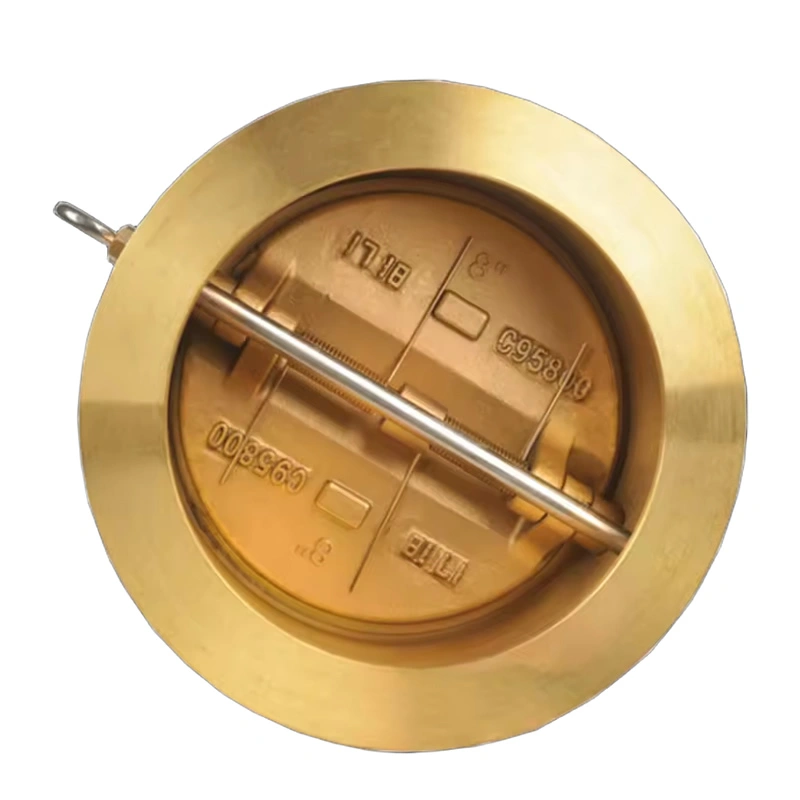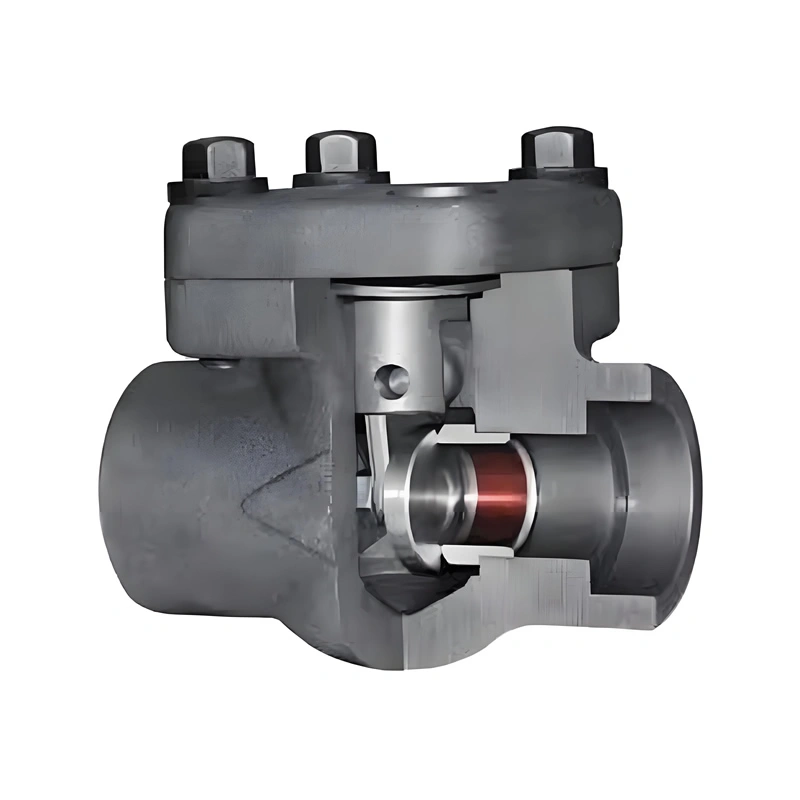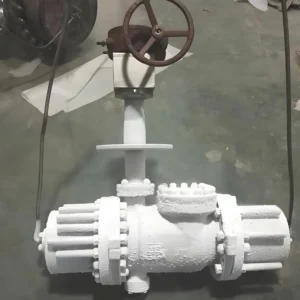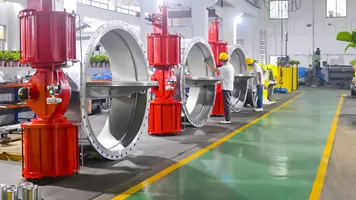I. Overview of Swing Check Valve: A Core Industrial Valve
In industrial pipeline systems, the Swing Check Valve is a critical device for controlling unidirectional fluid flow. Featuring a hinged disc design, it automatically opens during forward media flow and rapidly closes under gravity or media pressure during backflow, effectively preventing fluid reverse flow and ensuring safe, stable system operation. As a key player in the industrial valve sector, TIANYU has long been dedicated to the R&D and manufacturing of swing check valves. With advanced technology and strict quality control, we provide high-performance fluid control solutions for industries such as petrochemical, water treatment, and power energy.
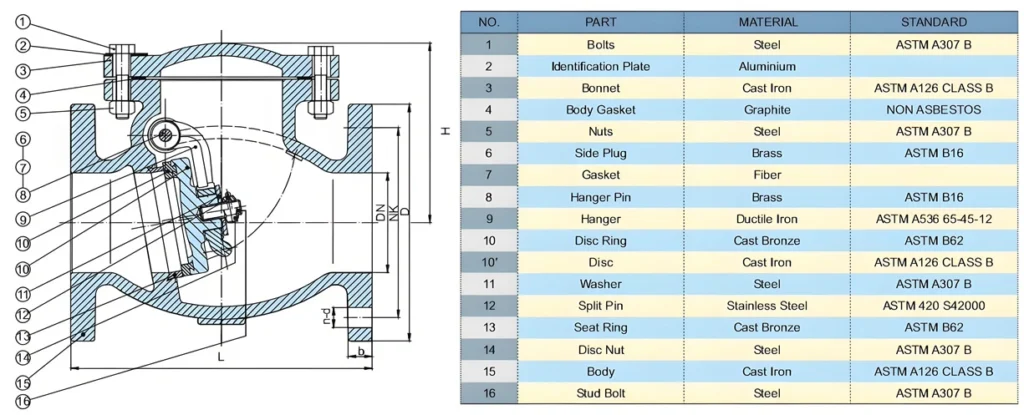
II. Structural Analysis and Working Principle
(I) Core Structural Design
TIANYU Swing Check Valves are primarily composed of a valve body, disc, hinge shaft, sealing seat, and drive mechanism:
- Valve Body: Adopts a full-bore streamlined design with smooth internal flow paths, achieving a drag coefficient as low as 0.5–1.2 to significantly reduce fluid pressure loss. Available in straight-through, Y-type, and other shapes to fit different installation space requirements.
- Disc: Connected to the valve body via a hinge shaft, allowing free swinging. Disc materials can be metal (e.g., carbon steel, stainless steel) or composite materials, with surface hardening to enhance wear resistance.
- Sealing Seat: Works with the disc to achieve sealing, divided into metal seals (suitable for high-temperature and high-pressure conditions) and elastic seals (suitable for corrosive media). Sealing performance complies with API 598, with a leakage rate controlled below 0.15×10⁻³ mm³/s.
(II) Operational Mechanism
- Forward Flow: When fluid acts on the disc with a forward pressure of ≥0.5 psi, the disc swings upward around the hinge shaft at an opening angle typically between 60°–90°, allowing unobstructed fluid passage.
- Backflow Cut-off: When fluid flow stops or reverses, the disc quickly falls back to the sealing seat under its own gravity and reverse pressure, forming a tight seal to prevent backflow. The entire process requires no external power, with a response time ≤0.3 seconds to ensure system safety.
III. Key Attribute Parameters and Technical Specifications
(I) Pressure and Temperature Adaptability
- Pressure Classes: Ranging from Class 150 (PN10) to Class 2500 (PN400), with a maximum working pressure of 450 bar, meeting full-range needs from low-pressure civil use to high-pressure industrial applications.
- Temperature Range:
-
- Metal-sealed type: -35°C to 450°C, suitable for high-temperature media like steam and thermal oil;
-
- Elastic-sealed type: -20°C to 230°C, ideal for low-temperature liquids and chemically corrosive media.
(II) Bore Sizes and Connection Types
- Bore Range: DN15 (1/2″) to DN900 (36″), with support for custom extra-large bores to meet special engineering requirements.
- Connection Types:
-
- Flanged connection: Complies with international standards such as ANSI B16.5 and ASME B16.47 for easy integration with different pipeline systems;
-
- Threaded connection: Uses standard threads like NPT and BSP for quick installation in small-bore pipelines;
-
- Butt-weld connection: Integrates with pipelines via groove welding to ensure sealing under high-pressure conditions.
- Butt-weld connection: Integrates with pipelines via groove welding to ensure sealing under high-pressure conditions.
(III) Material Selection and Performance
|
Component
|
Material Options
|
Typical Application Scenarios
|
Performance Indicators
|
|
Valve Body/Bonnet
|
WCB carbon steel, CF8/CF8M stainless steel, ductile iron, duplex steel (2205/2507)
|
General conditions/corrosion-resistant/high-pressure environments
|
Salt spray test ≥1000 hours without rust, tensile strength ≥450MPa
|
|
Sealing Seat
|
Stellite overlay, EPDM, Viton, PTFE
|
High-temperature/oil-resistant/corrosive media
|
Sealing surface hardness HRC≥45, friction coefficient ≤0.15
|
|
Hinge Shaft
|
304 stainless steel, 25Cr2MoVA alloy steel
|
High-load/high-speed conditions
|
Yield strength ≥600MPa, fatigue life ≥100,000 cycles
|
IV. Product Types and Technical Features
(I) Standard Swing Check Valve
- Structural Features: The disc is vertically installed in the valve body, featuring a simple structure and low manufacturing cost as the most commonly used basic model.
- Technical Advantages: Optimized flow path design minimizes pressure loss; gravity-driven disc requires no auxiliary devices, enabling easy maintenance.
- Application Scenarios: Water, air, and light oil transportation in municipal water supply, HVAC systems, and general industrial pipelines.
(II) Wafer Swing Check Valve
- Structural Innovation: No independent valve body; installed by clamping between two flanges, with an overall length 1/3 that of the standard type, saving up to 50% space.
- Performance Enhancement: Adopts a spring-assisted closing mechanism to increase closing speed by 30%, effectively reducing water hammer effects; lightweight disc design lowers the minimum opening pressure to 0.3 psi.
- Application Scenarios: Compact pipeline systems (e.g., ships, offshore platforms), high-viscosity media (syrup, slurry) transportation, and scenarios requiring rapid response.
(III) Tilting Disc Swing Check Valve
- Design Highlights: The disc is installed at an inclination (15°–30°), increasing the flow area by 20% compared to the standard type, suitable for low-flow and low-pressure difference systems.
- Technical Breakthrough: Floating sealing structure automatically compensates for sealing surface wear, extending service life; optimized flow path design reduces pressure drop by 15%, with significant energy-saving effects.
- Typical Applications: Aeration systems in wastewater treatment plants, farm irrigation pipelines, and chemical raw material transportation, especially suitable for media containing particulate impurities.
(IV) Y-Type Swing Check Valve
- Structural Advantages: Y-shaped valve body with a detachable inspection port, allowing maintenance of the disc and sealing seat without pipeline disassembly, reducing inspection time by 40%.
- Performance Features: Larger flow path curvature radius further reduces fluid resistance, with a Kv value 25% higher than the standard type; can be configured with a dual-disc design to improve stability under high-flow conditions.
- Application Fields: Sterile pipelines in the food and pharmaceutical industry (e.g., beverage filling lines, pharmaceutical pure water systems), and inlets/outlets of fine chemical reactors, meeting high cleanliness requirements.
V. Manufacturing Processes and Quality Control
(I) Precision Manufacturing Flow
- Material Preparation:
-
- Casting Process: Uses resin sand casting technology to control valve body wall thickness deviation within ±0.5mm; high-temperature annealing eliminates internal stress, increasing pressure resistance by 20%.
-
- Forging Process: For high-pressure valves (Class 600 and above), die forging is used to align material grains along the stress direction, improving fatigue resistance by 30%.
- Precision Machining:
-
- CNC lathes machine discs and sealing seats to IT7-level fit precision, with surface roughness Ra≤1.6μm;
-
- Laser cladding technology is used to overlay Stellite alloy on sealing surfaces, with a cladding layer thickness of 0.5–1.0mm and hardness uniformity error ≤5HRC.
- Surface Treatment:
-
- Internal and external surfaces are sandblasted to Ra≤12.5μm and coated with epoxy resin (thickness ≥200μm), achieving a salt spray test life ≥1500 hours and meeting ISO 12944 C5-M anti-corrosion standards.
(II) Full-process Quality Control
- Performance Testing: Each valve undergoes a 1.5x nominal pressure strength test and 1.1x sealing test; helium mass spectrometer leak detectors are used for leakage rate detection with a precision of 1×10⁻⁹ mbar·L/s;
- Nondestructive Testing: Ultrasonic testing (UT) and magnetic particle testing (MT) are performed on valve bodies to ensure no internal cracks or inclusions;
- Life Testing: Simulated working condition fatigue tests verify that valve opening/closing cycles ≥100,000 times with no sealing performance degradation.
VI. Core Product Advantages
(I) Excellent Fluid Control Performance
- Low Flow Resistance Design: Full-bore streamlined flow path combined with an optimized disc structure increases the Kv value by 25% compared to traditional check valves, reducing system energy consumption by 15%–20%;
- Rapid Response Capability: Spring-assisted valves have a closing time ≤0.2 seconds, effectively suppressing water hammer pressure to protect pipelines and equipment.
(II) Strong Working Condition Adaptability
- Wide Temperature and Pressure Range: Covers -35°C to 450°C and 0.1–450 bar, adapting to extreme media such as steam, LNG, and strong acids/alkalis;
- Contamination Resistance: Tilting disc and Y-type valves can pass impurities up to 5mm in diameter, reducing blockage risks in complex media conditions.
(III) Optimized Maintenance Costs
- Modular Design: Replaceable vulnerable parts such as discs, sealing seats, and hinge shafts reduce maintenance time by 50% and spare parts inventory costs by 30%;
- Long Service Life: Through hardening treatment and wear-resistant materials, the disc wear rate ≤0.01mm per 1000 cycles, extending service life by over 20% compared to similar products.
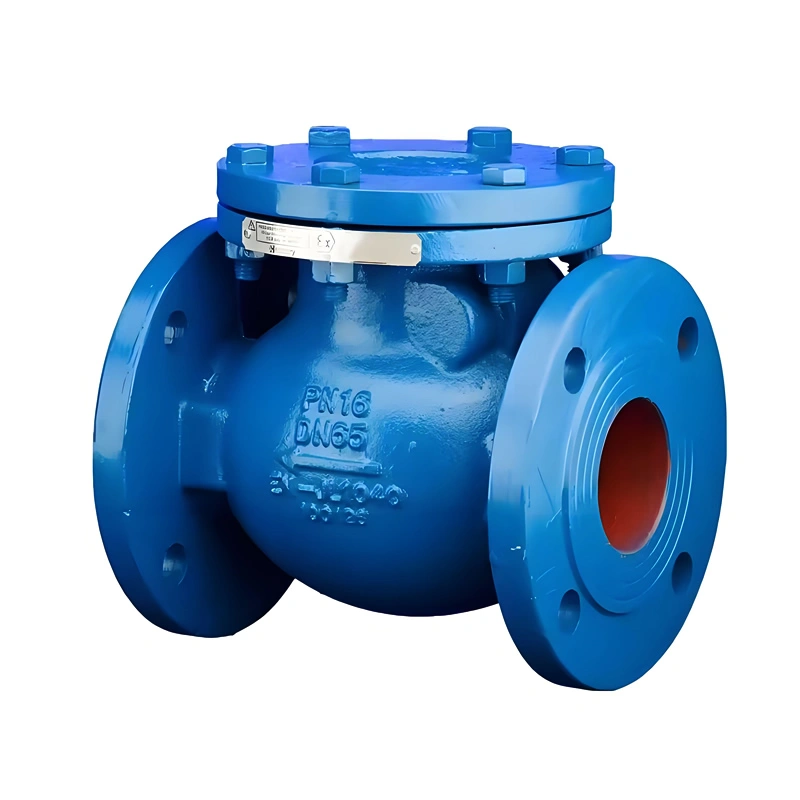
VII. Industry Application Scenarios
(I) Petrochemical Industry
- Crude Oil Transportation: Installed at the inlets/outlets of refinery atmospheric and vacuum distillation units to prevent high-temperature crude oil backflow from damaging pumps;
- Chemical Reactions: Prevents material backflow in polymerization kettle and reactor pipelines to ensure process safety;
- LNG Storage and Transportation: Cryogenic valves (-196°C) used in LNG storage tank vapor balance pipes to ensure sealing reliability.
(II) Water Treatment and Municipal Engineering
- Water Supply Systems: Prevents water hammer impacts in pressurized pump stations and high-rise building water pipelines, protecting pumps and pipe networks;
- Wastewater Treatment: Applied in aeration tank return pipes and sludge pump outlets to avoid activated sludge backflow;
- Flood Control: Installed at stormwater pump station outlets to prevent flood backflow into urban pipelines.
(III) Power Energy Industry
- Thermal Power Systems: Prevents steam backflow in steam turbine condensate recovery pipelines to improve thermal efficiency;
- Nuclear Power: Safety-class valves used in reactor coolant circulation systems, meeting seismic (Class 1) and sealing requirements;
- New Energy: Prevents oil backflow in wind turbine hydraulic circuits to ensure stable pitch system operation.
(IV) Food, Pharmaceutical, and Light Industry
- Food Processing: Sterile-grade valves (surface roughness Ra≤0.8μm) used in beverage filling lines and dairy sterilization equipment, complying with FDA and GMP hygiene standards;
- Pharmaceutical Industry: High-purity stainless steel valves (316L material) applied in pure water and liquid medicine pipelines to avoid media contamination;
- Paper and Printing: Controls unidirectional flow in pulp transportation and steam pipelines, reducing equipment downtime due to faults.
VIII. Selection Guidelines and Installation Maintenance
(I) Selection Considerations
- Media Properties:
-
- Corrosive media: Choose 316L stainless steel or duplex steel bodies with PTFE or Viton seals;
-
- High-viscosity media: Prioritize wafer or tilting disc valves to reduce opening resistance.
- Operating Parameters:
-
- Calculate valve bore size based on maximum flow (recommended velocity ≤3m/s) and select pressure classes according to system pressure-temperature curves;
-
- In low-temperature environments, use extended bonnets to prevent packing Envelope icing and failure.
- Installation Space:
-
- Choose wafer type for compact scenarios (short length); prioritize flanged connections for large-bore pipelines.
(II) Installation Specifications
- Flow Direction Confirmation: Install strictly according to the arrow identification on the valve body; reverse installation will cause valve failure;
- Pipeline Support: Set fixed supports at both ends of the valve with a spacing ≤5 times the pipe diameter to avoid pipeline stress transfer to the valve body;
- Sealing Treatment: Use gaskets compatible with media properties (e.g., spiral-wound metal gaskets, rubber gaskets) for flanged connections, and tighten bolts uniformly according to standard torque.
(III) Maintenance and Servicing
- Regular Inspections: Clean valve internal impurities every 6 months and lubricate hinge shafts annually with food-grade grease (for hygiene-class valves);
- Leakage Handling: When detecting seal leakage, first check for wear or foreign objects on the sealing surface; lightly worn surfaces can be ground, and severely damaged components should be replaced;
- Performance Testing: Conduct pressure and sealing tests every 2 years to ensure valve performance meets design requirements.
IX. Industry Standards and Certification Systems
TIANYU Swing Check Valves strictly adhere to international and domestic standards:
- Design Standards: API 6D (Petroleum and Natural Gas Industry), API 594 (Wafer Check Valves), ASME B16.34 (Valve Pressure-Temperature Ratings);
- Testing Standards: API 598 (Leak Test), ISO 15848-1 (Volatile Organic Compound Emissions), BS 6755-2 (Water Hammer Test);
- Certifications: CE, UL, FM, SIL 3, and compliance with safety specifications such as EU PED and US ASME BPVC, meeting market access requirements in major global regions.
X. Technological Development Trends and Innovation Directions
(I) Industry Trends
- Intelligent Upgrades: Integration of pressure sensors, temperature transmitters, and IoT modules enables remote valve status monitoring and fault early warning; predictive maintenance technology reduces downtime by 40%;
- Green Manufacturing: 3D printing for complex flow path components increases material utilization from 60% to 95%, reducing carbon emissions by 30%;
- High-Pressure and Corrosion-Resistant Demand: With the development of deep-sea oil and gas extraction and new energy material processing, demand for Class 2500+ high-pressure valves and special alloy valves resistant to strong acids/alkalis continues to grow.
(II) TIANYU Innovation Practices
- Self-Cleaning Sealing Technology: Nano-ceramic coating (50–100μm thickness) on the disc surface with a hardness of HV1500+ effectively prevents scaling and particle adhesion, reducing maintenance frequency;
- Low-Noise Design: Fluid dynamics simulation optimizes disc contours, combined with damping spring components, reducing valve operating noise from 85dB to 72dB, compliant with ISO 3744 industrial noise control standards;
- Lightweight Material Application: Development of titanium alloy (TA2/TC4) valve bodies, reducing weight by 40% compared to stainless steel, suitable for special fields such as aerospace and deep-sea exploration.
As the “safety guardian” of industrial pipeline systems, TIANYU Swing Check Valves have become a reliable choice for fluid control across industries, thanks to exquisite manufacturing processes, diverse product portfolios, and excellent performance. From conventional to extreme conditions, and from basic to customized products, TIANYU Always focuses on customer needs, continuously driving technological innovation and quality upgrades. In the future, with the acceleration of global industrial intelligence and greening, TIANYU will continue to deepen its expertise in fluid control, contributing to the construction of efficient, safe, and sustainable industrial systems.


